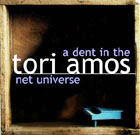
|
Article In The Tulsa World Newspaper
|

|
Article In The Tulsa World Newspaper
|
This article was emailed to me by Lyvia.
"Tori Amos Compares Rock to Classical in the Context of Jimi Hendrix,
Ripples in a River...and Stinky Cheese"
By: Thomas Conner, Tulsa World Newspaper
Friday, November 1, 1996
There is nothing wrong with your stereo system. Tori Amos is controlling the transmission. She can control the vertical, she can control the horizontal. For the next 18 tracks she will control all that you hear and think. You are listening to a drama that reaches from the inner mind to the outer limits.
It's not sci-fi, but the lyrical and musical world of Tori Amos is definitely out there--or in here, in the heart--and her space is just as alternately chilly and boiling as the Milky Way. Her songs are rich, evocative and abstract, and they cannot, no matter how hard a fussy music critic may try, be pinned down.
"Things aren't always what they seem," Amos said in an interview this week. "Things can't be so defined. The edges have to sort of... there has to be a fluidity. I'm looking at the river now, you see, and I can't tell one ripple from another."
That one quotation speaks volumes to Amos's body of music--three albums thus far of classically rooted, girl-and-piano, awe-inspiring emotion. Things are rarely as they seem, and nothing is defined. The songs are as full of abstract symbols as one of Jung's visions (and just as subjective), and the verses usually drift into a soundbite lyric we can hang onto ("God, sometimes you just don't come through").
Her remarks about blurring the edges, though, was in response not to my probing the abstract nature of her poetry but to my futile attempt to break down the music into a hybrid of classical structures and rock 'n' roll spirit. Breaking down Amos' music is something that can be done, but should not be. She is best enjoyed in the abstract, and if the scattered bits of meaning in the songs happen to ring a chord in your soul, so be it. What you bring to the experience is what you get.
Amos swirls together the spirits of both classical and rock music--not the actual musical styles (not the orchestrated rock of the Moody Blues or Yes) but the spirits. She bangs and tinkles on the piano and translates the most inimate sexual and spiritual matters into music. It sounds classical because she's playing a Bosendorfer piano or a harpsichord, but when she phrases a greeting like, "How's your Jesus Christ been hanging?" ("Father Lucifer" from "Boys for Pele") you hear the rock 'n' roll. In addition, the harpsichord is being run through a Marshall amplifier.
"There is no dividing line between any of this," Amos said. "What we call classical music now was not perceived then as it is today. These composers--Mozart, Bartok--were the Jimi Hendrixes of their day. So, now, when we see people with stinky cheese and glasses of wine, that's not what was indigenous to those guys. They were broke, with all sorts of veneral disease. They were mercenaries, hired by the court to write this stuff. Some of them broke that mold. So this 'classical' music was the rock n roll of its day."
Musical genres compliment each other in that same spirit, she said. "Look at Hendrix or Jimmy Page. They were both influenced by jazz, which came out of tribal and classical roots. You can't seperate them. A great jazz player and a great classical player would have a lot to talk about over a margarita. Two great classical players, though, wouldn't have much to say."
The blend of styles in her music is reflective of Amos' life. Born in North Carolina, daughter of a Methodist preacher, she could play the piano by age 2 and was composing scores at age 4. At 5 she was packed off to the Peabody Conservatory in Baltimore to become a concert pianist. The idea didn't take, and Amos found herself more interested in free expression. She was expelled at age 11.
She spent the next several years playing Gershwin standards in the gay bars of Washington, D.C. and Baltimore. In 1987, she pushed forward a rock n roll project, a band called Y Kant Tori Read? that quickly went nowhere. Turning back to the piano, she emerged on her own and released her first solo album, "Little Earthquakes" in 1991.
"I went to the band thing because I wanted interaction with other musicians," Amos said. "Everyone had said the girl-and-a-piano thing would never work, and I had started to believe them. The band got signed because (record companies) were looking for another Pat Benatar."
Please give me feedback, comments, or suggestions about my site. Email me (Michael Whitehead) at mikewhy@iglou.com
